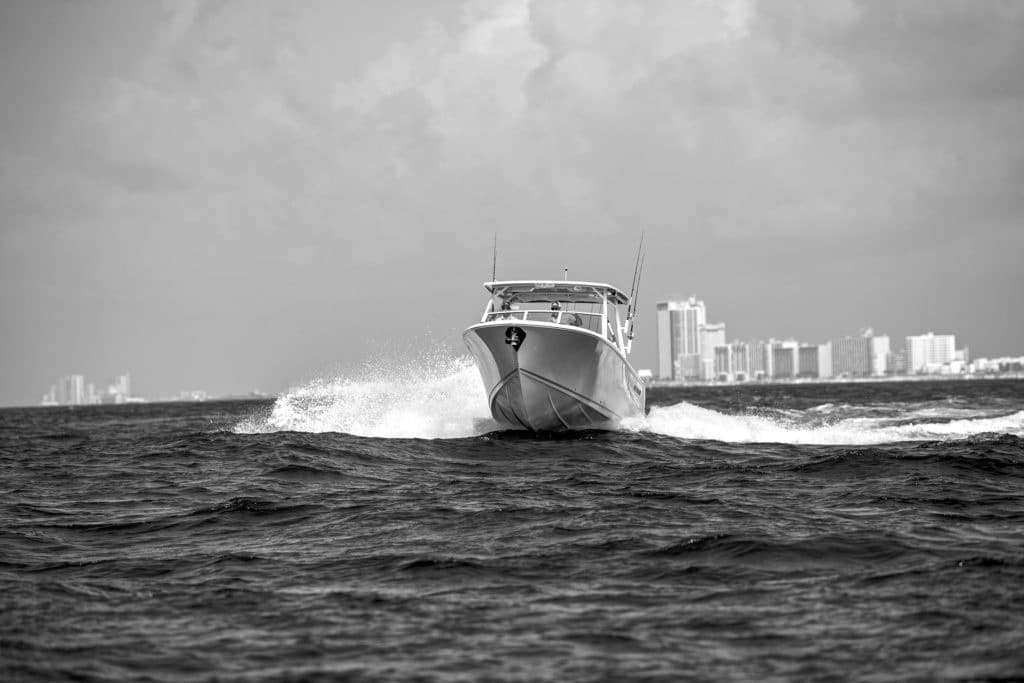
The first word that comes to mind in terms of a boat’s performance is almost always horsepower. But as racetrack punters know, there are “horses for courses.” Some horses run best on a dry track, some in mud. A Clydesdale—that Caterpillar tractor of draft horses—would be as out of place at the Kentucky Derby as a sleek Thoroughbred would be pulling a plow. With that in mind, in the world of boats there’s something major to think about beyond propulsion, and that is hull shape.
Boats possess deep-V hulls, flat-bottomed hulls, and everything in between, and that’s just monohulls. Catamarans open up a whole other dimension. Some boats are perfect for bonefishing the flats in smooth water; others are best skating along in offshore races or heading for the canyons to fish for tuna.
But the one goal of modern boatbuilders has been to create a boat for all reasons, one that’s seaworthy and comfortable in ocean swells, stable in a beam sea at rest and underway, fast in all conditions and, of course, economical.
In attempts to achieve this goal, boatbuilders over the years have engineered and endlessly refined running surfaces. This has included developing hulls that transition in angle and shape both longitudinally and transversely, as well as adding hull structures such as chines, pads, strakes and steps.
To gain a better understanding of such design elements, let’s define each and explain how they affect performance by focusing on one example—the new Sailfish 276 DC, a dual-console boat designed to meet the needs of fishing families.
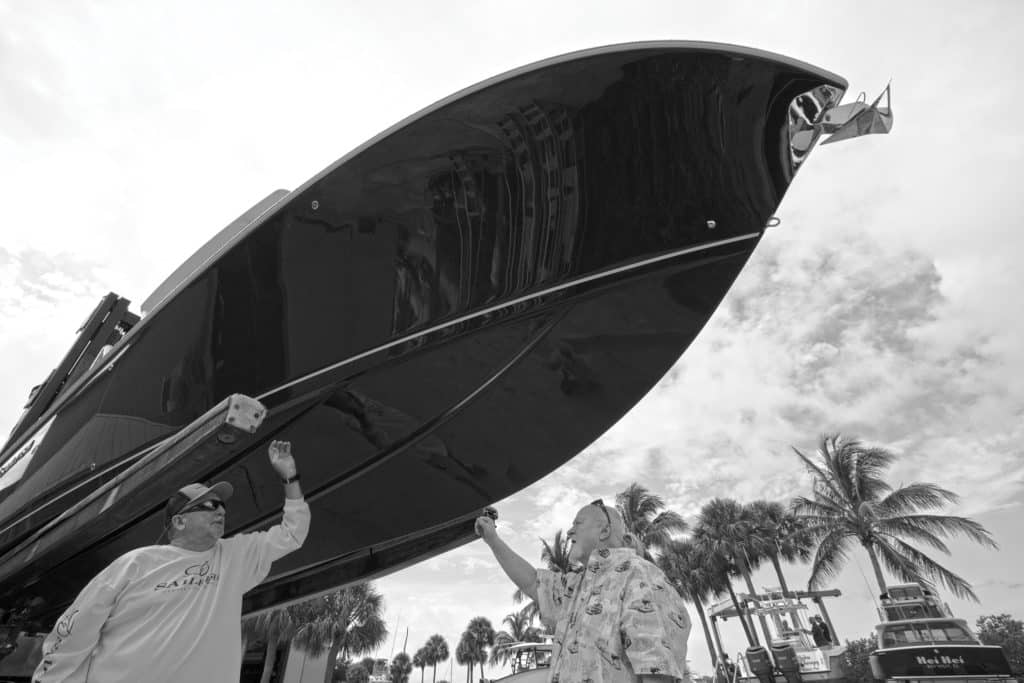
Deadrise Definition
Certainly, one of the most important terms to understand in monohull design is deadrise. Quite simply, this is the angle of the hull up from the very bottom, measured in degrees. Imagine the boat sitting level on the ground. Deadrise is the angle between the ground and the bottom of the hull, often measured at the transom, which represents the least acute angle of a hull.
A flats boat may have a deadrise at the transom of just a couple of degrees, while a serious offshore deep-V will be in the 24-degree range. On rivers and lakes, you might find boats with little deadrise that are fast with modest power because the bottom is, well, flat. When the afternoon chop comes up, however, they ride rough and wet. (Horses for courses.)
Imagine hitting the water with an ax. That’s a V-bottom. It slices more cleanly into the water. Then imagine hitting the water with a frying pan. That’s a flat or low-deadrise hull. It pounds your wrist. The challenge for designers is to come up with a boat that does it all well. Impossible?
New Angles
Let’s dive deeper into the esoterica of V-hulls and discuss variable deadrise. Some boatbuilders mislabel variable deadrise as all-purpose, claiming that because the hull shape twists from a sharp entry at the bow to a flatter aft section, their hull provides the wave-slicing ability of a deep-V with the speed, stability and economy of a flatter hull. Some boatbuilders refer to this as “continuously variable vee” hulls, hoping to capitalize on the luster of deep-V hulls.
The correct term for this shape, however, is “warped plane.” Imagine taking a piece of light plywood and twisting it. This is a warped plane. Almost all V-hull boats have variable deadrise as the running surface transitions from very sharp (58-plus degrees) at the bow to whatever the builder chooses at the transom. Some carry the transom deadrise angle fairly far forward and can be said to have “constant deadrise,” even though the deadrise does vary from that point to the bow.
True variable-degree deadrise, on the other hand, changes the angle at various points on a cross section of the hull. Imagine slicing through the hull from side to side like a loaf of bread. If the hull displays a deeper deadrise at the keel than it does at any section—or slice—of hull, then this is variable deadrise. This offers the best of a deep-V for slicing waves, and then morphs into shallower deadrise for stability at rest while also boosting both speed and economy when running in mild conditions.
The Sailfish 276 DC features the variable-deadrise concept, which provides a good balance between speed and stability. During our test, the 276 DC felt solid and predictable, without any surprises whether turning hard or running through our own wake. The combination of hull shape, strakes and reversed chines (more on these later) made the hull stable at rest in chop, even when the crew moved from side to side.
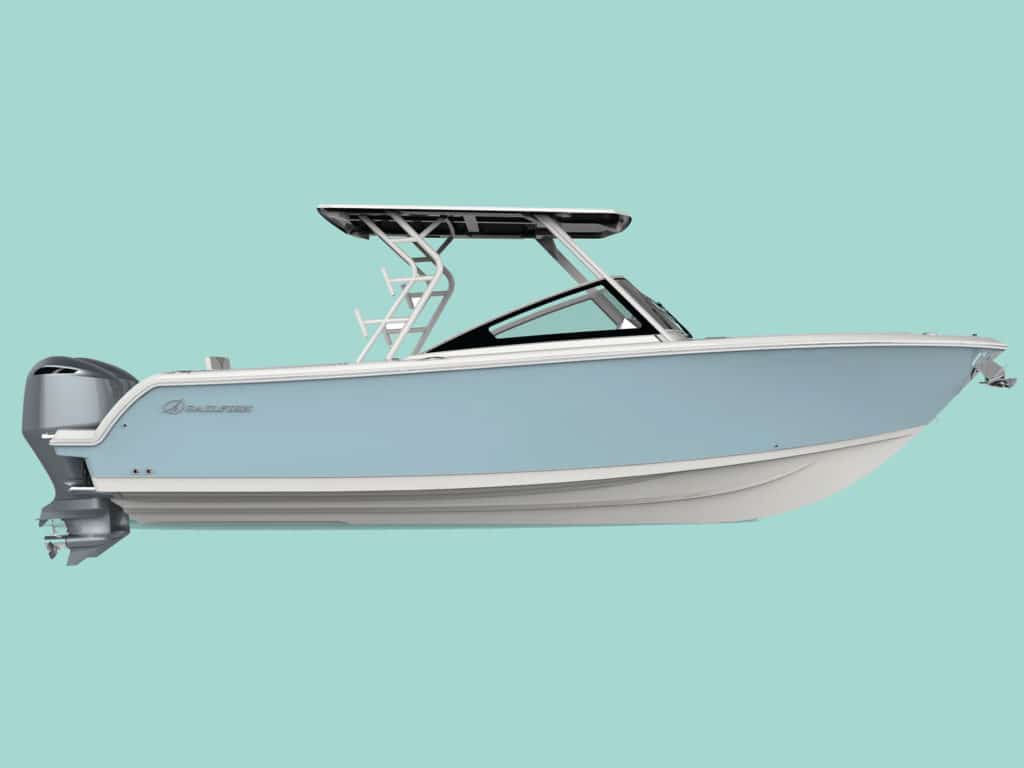
Step Class
The Sailfish 276 DC also has steps in the running surface. The company calls this design by the name variable-degree stepped hull (VDS).
Steps generally consist of two or three specially designed notches running athwartships across the boat to introduce aerated water under the running surface to lift the hull and reduce drag, thus boosting efficiency and speed. These are found in a wide range of saltwater fishing boats from a variety of builders, including Barker, Contender, Invincible, SeaVee, Yellowfin and others.
Yet Sailfish’s VDS hull differs from other stepped hulls. The VDS hull has carefully staged changes in deadrise of a degree per panel, so each strake marks a different task. These are not “notches” crossing under the hull for aeration; they are fore-and-aft panels for ride comfort. At the lowest panel (from the keel to the first strake), the deadrise is 24 degrees, or the same as many offshore-racing powerboats. Running flat-out, this amount of deadrise keeps pounding to a minimum. The next two panels flatten the deadrise to 22 degrees, providing more lift for speed and economy, as well as more stability at rest. The result is a good compromise between the ability to slice through swells and to run fast (45 mph) on smooth water.
Launch Pad
The 276 DC hull is based on design assets of the original SeaCraft boats designed by Carl Moesly (see “Moesly’s Variable Deadrise”), which Sailfish acquired years ago. Since that time, Sailfish has modified the design to reflect modern technology. This includes widening the hull aft to carry the weight of heavier, more powerful outboards, and adding a flat spot known as a pad.
Located on the aft keel and found on many boat models today, a pad is simply a flat surface that tricks the water to achieve the benefits of a flat-bottomed hull: speed (in smooth water), faster acceleration and stability (when at rest and running flat-out). In the case of the 276 DC, the pad is just over 6 feet (73 inches) in length (from the transom) and about 8 inches wide, tapering smoothly into the V forward.
A well-designed keel pad should result in faster planing and better stability. In testing the 276 DC, this was most evident in two areas. First, we came onto plane quickly (3.6 seconds), but without as much bow rise as I expected because of the lift from the pad. Second, when running flat-out, there was a stability more akin to a flat-bottomed hull than to a true deep-V, which can “chine-walk,” or rock from side to side as each hull side fights for traction.
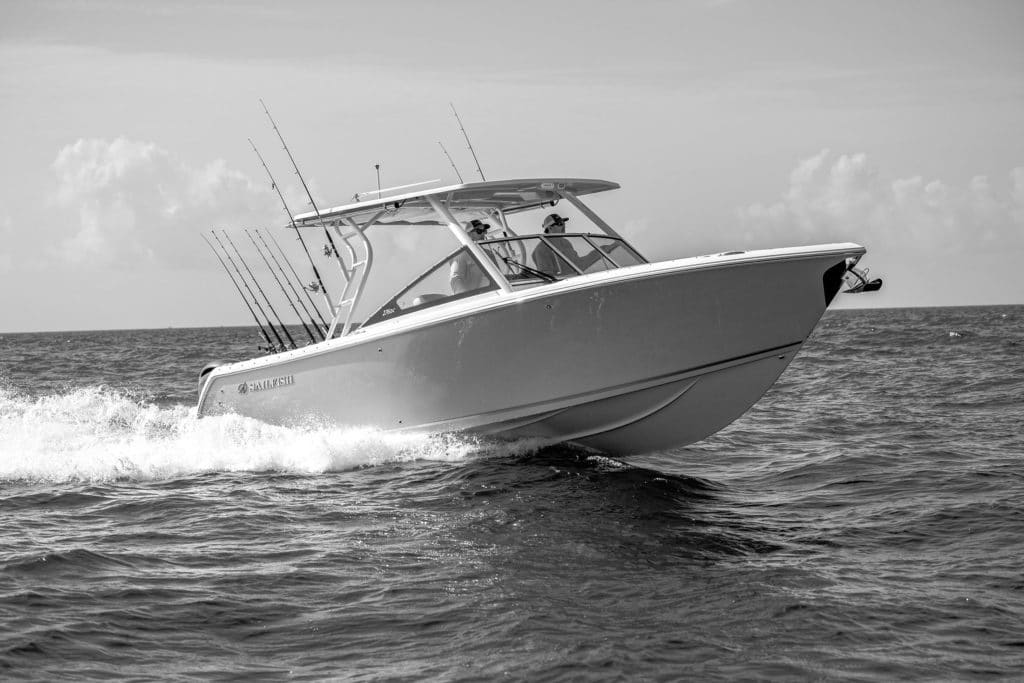
Strakes of Genius
One of the biggest changes to the old SeaCraft lies in the addition of full-length strakes running on the edge of each bottom panel. Where the SeaCraft simply ended one panel as though it was the edge of a plank, the 276 DC hull now has two strakes slightly turned down running fore and aft.
This is certainly not unique to the 276 DC because many models from other boat brands have similar hull structures. And that’s not surprising given that such strakes add immense rigidity to the hull panels, and also provide both lift and cushioning effects as the hull reenters the water in lumpy seas.
Sailfish has painstakingly balanced the size and shape of the strakes to minimize drag while maintaining their cushioning effect. Many builders use a simple triangular strake, but the 276 DC’s strake is slightly reversed, giving it added lift. This was noticeable during our test when we went through several large wakes at high speed. I braced for a crash, but the strakes cushioned the impact, each acting to defuse the collision with the water.
Chine Design
Early deep-V hulls such as the SeaCraft design were noted for their seaworthiness offshore. But these hulls also had a well-earned reputation for being very wet and for excessive rolling at low speeds in beam seas.
That’s because the original SeaCraft hulls had no flat spot where the hull turned upward into the hull sides. This is known as a chine. Today, you can find this shape on many V-hulls.
Sailfish decided to add chines to its hulls on each side. This includes flat sections with outer edges turned slightly down. These are known as reverse chines, and they are designed to accomplish two things. First, they improve stability while low-speed trolling or when a portly crewmember decides to move to one side. Second, they throw spray flat and to the sides rather than allowing it to curl upward and into the boat. That makes for a drier ride.
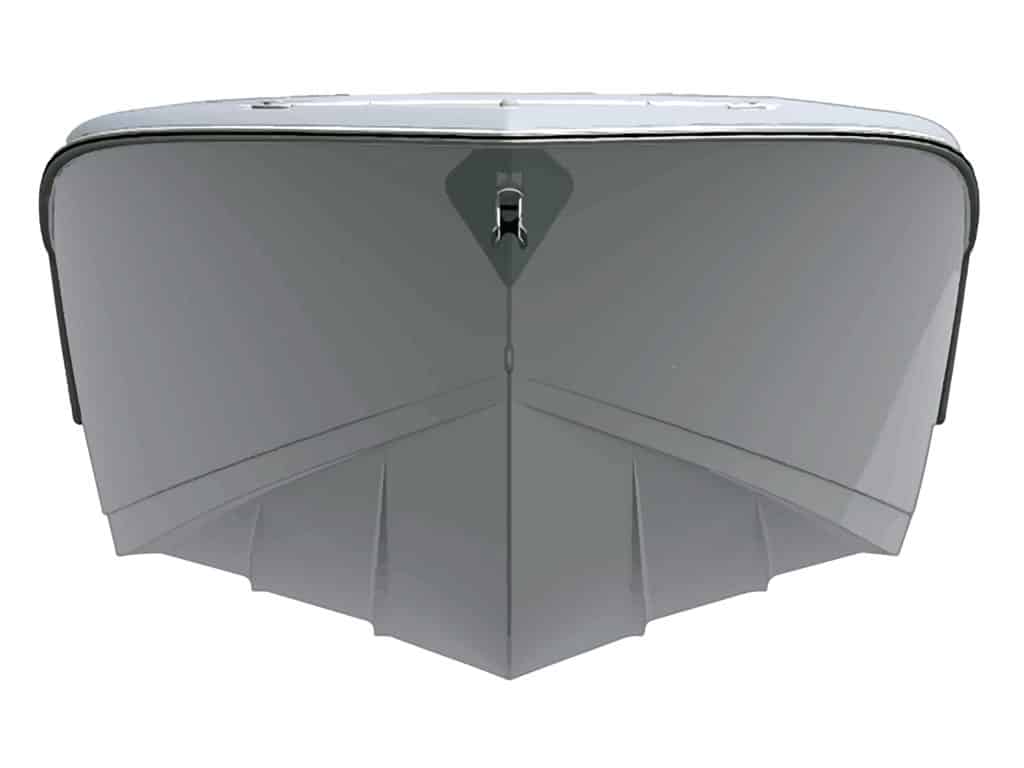
During my test of the Sailfish 276 DC, I hung far over the side to watch how the water was exiting the hull. Sure enough, that chine turned slightly down did throw the water and spray aside. When we were stopped and rolling slightly in the remains of our wake, it clearly helped stabilize the hull as well. The reverse chines also helped soften the impact of each roll, making for a gentler motion.
So, as a boat buyer, you have two tasks. First, decide on your needs. Flat water? Offshore swells? Family outings in fair weather? Second, examine the hull shape carefully, keeping in mind that proven hull shapes and designs, like variable deadrise, pads, steps, strakes and chines, offer genuine benefits in terms of improved lift, faster hole shot, better efficiency, greater stability and a softer, drier ride.
Ultimately, however, you need give the boat a good test ride to make sure it meets your needs and is suitable for the types of water on which you plan to boat.
Moesly’s Variable Deadrise
The variable-degree deadrise shape was patented by Floridian Carl Moesly in the early 1960s for hulls of his legendary SeaCraft line of center-console boats, the same hull that served as the basis (with major modifications) for the running surface of the Sailfish 276 DC. Moesly’s design featured three separate panels running fore and aft, each changing by about a degree from the initial 24-degree deep-V at the keel. (Imagine a shingled roof upside down.)
Moesly was a tinkerer, a World War II combat pilot, and an avid boatman who believed in testing his ideas under trying conditions. He had built his first boat at 13, and as he formulated SeaCraft, he studied the newly launched Bertram deep-Vs. He knew that the high deadrise of the early Ray Hunt-designed Bertram deep-Vs were low on lateral stability. They were, in a word, rollers. What he wanted was a good rough-water boat for running off Florida in the Gulf Stream in all conditions.
In 1961, Moesly entered a 23-foot wooden SeaCraft prototype in the grueling Miami-to-Nassau powerboat race and, despite a 25-minute delay to sort out carb problems, finished fifth overall. Powered by a pair of 110 hp Mercury outboards, it finished just 25 minutes behind a 1,000 hp competitor.









